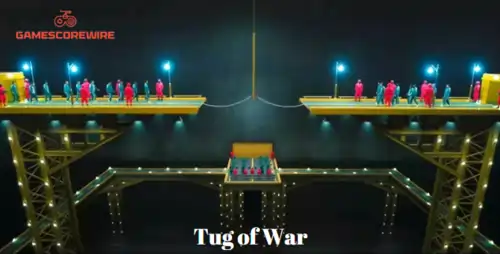
Table of Contents
Introduction
In Squid Game, Episode 4 introduces “Tug of War,” a game that transforms a beloved childhood pastime into a brutal battle for survival. This episode shifts the focus from individual prowess to teamwork, testing the players’ ability to collaborate under life-threatening conditions. The high-stakes game forces participants to face their fears, confront their weaknesses, and trust their teammates in a setting where failure is unforgiving.
Overview of “Tug of War”
Basic Rules of the Game
“Tug of War” follows the traditional format familiar to many: two teams compete to pull a rope until the opposing side crosses a dividing line. However, in Squid Game, this dividing line represents a deadly drop. The losing team is pulled off a platform and falls to their death, turning a seemingly innocent game into a horrifying ordeal.
Purpose in the Show
This game serves as a pivotal moment in Squid Game, illustrating the shift from individual challenges to team-based survival. It introduces themes of unity, strategy, and the tension between physical strength and mental acuity, further deepening the psychological complexity of the series.
Key Entities and Elements
The Rope and Platform
The game’s central element is a thick rope suspended over a massive pit. Teams stand on narrow platforms at either end, tethered to the rope. The visual of the deep drop adds a layer of dread, making each pull of the rope a visceral reminder of the stakes.
The Teams
Each team is composed of ten players, and the composition of the group plays a significant role in their success:
- Seong Gi-hun’s Team: A seemingly mismatched group with apparent disadvantages, including an elderly man, Oh Il-nam, and weaker members like Ji-yeong and Han Mi-nyeo. Despite their lack of physical strength, they prove the value of strategic thinking.
- Physically Dominant Opponents: Other teams rely heavily on brute force, selecting the strongest and most muscular players. While initially intimidating, this approach exposes a critical flaw when pitted against a strategic team.
The Overseers
The masked guards monitor the game with their characteristic detachment, ensuring strict adherence to the rules. Their presence heightens the tension, as their role as enforcers makes the threat of death tangible.
Challenges and Strategies in “Tug of War”
Physical Strength and Imbalance
At first glance, “Tug of War” appears to favor teams with superior physical strength. This assumption creates a sense of hopelessness for weaker players who feel doomed against more muscular opponents.
Strategic Ingenuity
Seong Gi-hun’s team proves that strategy can overcome physical disadvantages. Under Oh Il-nam’s guidance, they employ clever techniques:
- Balanced Formation: The team alternates strong and weak members along the rope to maintain equilibrium.
- Anchoring: Three players stand at the back to serve as an anchor, leaning back to maximize resistance.
- Initial Hold: The team locks the rope and remains stationary for 10 seconds, destabilizing the opposing side’s rhythm and tiring them out.
- Final Push: A synchronized forward step catches the enemy team off-guard, causing them to lose balance and fall.
Mental and Emotional Strain
Beyond physical exertion, the game’s psychological impact is immense. Players must suppress fear and self-doubt while placing their trust in teammates, even when failure means certain death.
Symbolism and Themes in “Tug of War”
Strength vs. Strategy
The episode underscores the idea that raw strength is not always the key to survival. Intelligence, coordination, and creativity can level the playing field, offering hope to those perceived as weaker.
The Importance of Unity
“Tug of War” highlights the power of teamwork and trust in overcoming adversity. It demonstrates that even a disparate group of individuals can achieve great things when working toward a common goal.
The Role of Luck and Desperation
The random assignment of teams adds an element of chance to the game, reflecting the series’ broader commentary on the arbitrary nature of success and survival in society. Desperation drives players to dig deeper than they thought possible, showcasing the extremes of human endurance.
Societal Reflection
The episode mirrors real-world struggles, where collaboration and strategy are often overshadowed by physical dominance or wealth. It challenges viewers to reconsider traditional notions of strength and power.
Impact on Viewers
“Tug of War” captivated audiences with its blend of physical intensity, psychological tension, and emotional resonance. The transformation of a childhood game into a life-or-death struggle resonated with viewers worldwide, offering a powerful commentary on the human condition. The clever strategies and raw desperation displayed by the players made the episode one of the most memorable in the series.
Final Thoughts
“Tug of War” in Squid Game is more than just a test of strength; it’s a powerful exploration of teamwork, strategy, and resilience in the face of overwhelming odds. By pitting underdogs against seemingly unbeatable opponents, the episode underscores the value of unity and ingenuity, delivering a heart-pounding narrative that leaves viewers questioning the boundaries of human survival.
Disclaimer: This article is for informational and entertainment purposes only. It discusses fictional content from the television series Squid Game. All rights to the series, characters, and associated content belong to their respective creators and copyright holders.








